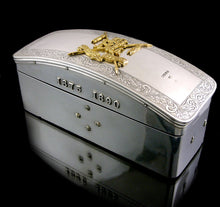18th Bengal Lancers, 1890
Adding product to your cart
Length: 18cm (7ins)
A regimentally specific Victorian cavalry officer’s pouch flap hallmarked Birmingham 1886 by Joseph Jennens & Co., converted for use as a trinket box by London silversmiths William Gibson and John Langman; the base bearing hallmarks for London 1898, and further applied with the dates 1875-1890.
Hart’s Army Lists reveal there is only one officer of the 18th Bengal Lancers whose regimental service spans the years 1875-1890, this being Major-General G.L.R. Richardson, C.B., C.I.E., who joined the corps in 1874 Cavalry and rose to become Commandant. In 1893, he was selected to command the representatives of Indian Cavalry sent to England to escort Queen Victoria at the opening of the now long defunct Imperial Institute in South Kensington.
Read more
The 18th Bengal Lancers was raised in 1858 at Gwalior as the Tiwana Horse - Tiwanas being a Mussalman Rajput class from Jhelum & Shahpur. In 1886, the hallmarked date of the pouch flap the, regiment was retitled 18th Regiment of Bengal Lancers. The regiment served in the Second Afghan War and in the Tirah Expedition of 1897-98. In 1903 they became the 18th Tiwana Lancers, then in 1906 the 18th (Prince of Wales's Own) Tiwana Lancers. In this guise they acted as King George V's escort for the state entry into Delhi for the Coronation Durbar. The regiment was in France in December 1914, transferring to Palestine in 1918. It returned to India in November 1920, and amalgamated with the 19th Lancers (Fane's Horse) at New Delhi on 23 Aug 1921, as the 18th/19th Lancers. The regiment played a distinguished role in the Second World War as 19th King George V's Own Lancers. At partition in 1947 the regiment was allotted to Pakistan, and is now known as the 19th Lancers.
Originally worn by cavalrymen as containers for carbine rifle ammunition, shoulder belt pouches assumed purely decorative usage in the mid 19th century. Later in the century the tradition of recycling the silver elements of an officer’s uniform for domestic use was developed with a number of prestigious London silversmiths carrying out the work to order.
http://www.agefotostock.com/en/Stock-Images/Rights-Managed/HEZ-2365685






